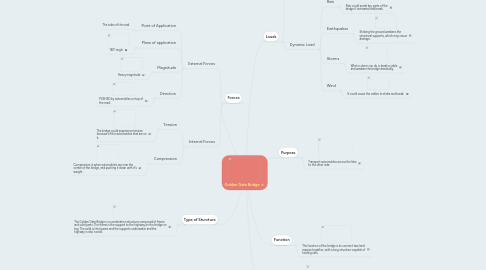
1. Type of Sturcture
1.1. The Golden Gate Bridge is a combination structure composed of frame and solid parts. The frame is the support to the highway on the bridge on top. The solid is the towers and the supports underwater and the highway is also a solid.
2. Forces
2.1. External Forces
2.1.1. Point of Application
2.1.1.1. The sides of the road.
2.1.2. Plane of application
2.1.2.1. 180° angle
2.1.3. Magnitude
2.1.3.1. Heavy magnitude
2.1.4. Direction
2.1.4.1. PUSHED by automobiles on top of the road.
2.2. Internal Forces
2.2.1. Tension
2.2.1.1. The bridge could experience tension because of the automobiles that are on it.
2.2.2. Compression
2.2.2.1. Compression is when automobiles are near the center of the bridge, and pushing it down with it's weight .
3. Purpose
3.1. Transport automobiles across the lake to the other side.
4. Form
4.1. The form of the bridge is very long, tall and thick with suspension cables supporting it between the tall towers.
5. Function
5.1. The function of the bridge is to connect two land masses together, with a long structure capable of holding cars.
6. Loads
6.1. Static Load
6.1.1. The bridge is the dead load part of the static load, and the live is the automobiles on the structure.
6.2. Dynamic Load
6.2.1. Rain
6.2.1.1. Rain could erode key parts of the bridge if untreated and break.
6.2.2. Earthquakes
6.2.2.1. Shaking the ground weakens the structural supports, which may cause damage.
6.2.3. Storms
6.2.3.1. What a storm can do is break a cable and weaken the bridge drastically.
6.2.4. Wind
6.2.4.1. It could cause the cables to shake and break.

